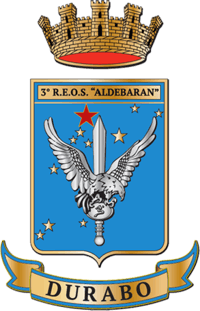3rd Special Operations Helicopter Regiment
| 3rd REOS Special Operations Helicopter Regiment | |
|---|---|
 | |
| Active |
10 November 2014 today - |
| Country | Italy |
| Allegiance | Italian Army |
| Branch | Aviation |
| Role | Special Operations |
| Size | Regiment |
| Part of | Army Aviation Regiment of Army Aviation Brigade ( Army Aviation Command) |
| Garrison/HQ | Airport of Viterbo, "T.FABBRI" |
| Motto(s) | Latin: "Durabo", that means "I will resist". |
| Anniversaries | november 10, 2014 |
| Equipment |
Agusta Bell 412 CH-47Cs Plus Chinook NH-90. ICH47-F |
The 3rd Special Operations Helicopter Regiment Aldebaran (in Italian language 3° Reggimento Elicotteri Operazioni Speciali” -REOS, former 3rd Army Aviation Regiment)[1] is a Special Operation Forces unit of the Italian Army that conducts Special Air Operations supporting the other Italian Special Operations Forces units, both Tier 1 and 2. The 3rd REOS is headquartered in Viterbo near Rome.
The motto of the 3rd REOS is the Latin word “Durabo”, which means “I will resist”, whereas the name “Aldebaran” is dedicated to the brightest star of the Taurus constellation, as it is for each regiment in the Italian Army Aviation.
Overview
The regiment was established on 10 November 2014 in Viterbo, during a ceremony held at the “Fabbri” military airport. The regiment inherited the name and the war flag from its predecessor based in Bresso (Milan), which was disbanded in 1998.
On 19 November 2014, the war flag of the 3rd Army Aviation Regiment “Aldebaran”, kept safe since 1998 at the flag memorial “Vittoriano” in Rome, was granted to the new Special Operations Helicopter unit, to symbolize the transfer of ethos.
The regiment includes the pre-existing 26th Army Aviation Group “Giove”. This unit, the first of its kind, specifically dedicated to Special Air Operations, was established in 2002 by merging the 51st Army Aviation Group “Leone” (based in Viterbo), the 39th “Drago” (based in Alghero) and the 26th “Giove” (previously based in Pisa).
The 3rd Regiment was established following an ad hoc study carried out by the Italian Army General Staff, related to the reform of the Special Forces sector. In particular, the 26th Group was upgraded at regimental level, in order to meet the necessary ambition to support the national special forces, providing enhanced air mobility. That ambition was to provide the capability to originate the framework of a joint-combined Special Operations Air Task Group -SOATG, based on, at least, two Special Operation Air Task Units, potentially integrated by Direct Support Air Task Units and all supported by Combat Service Support elements.
The regiment, which is nowadays validated at NATO level as SOATG, is based on four fleets, i.e. CH-47 C and F, AB-412 and NH90, and is able to conduct the full spectrum operations to accomplish the three tasks of special operations (Special Reconnaissance, Direct Actions, Military Assistance), performing several activities including counter-insurgency, counter-terrorism, etc..
The 26th squadron, the operational battalion of the regiment, whose motto is “Numquam Periculum Sine Periclo Vincitur” (No danger can ever be overcome without risk), can perform several tasks, detaching Special Operations Air Task Units –SOATU- to conduct Special Air Operations supporting the other Italian Special Operations Forces units, in accordance to the NATO SOF doctrine. The SOATUs are therefore capable to conduct operational missions on short notice, in multiple environments, at day/night, in most weather conditions, opting for discreet, covert, or low prominence flight modes, with a time-on-target within +/- 1 minute.
Selection and Training
Selection and training is very rigorous and is tailored according to the basic Italian Special Forces training syllabus. There is first a selection phase divided into two steps and then a training phase. The first part of the selection phase is based on several psychological and fitness tests. The second part of the selection process lasts two weeks and puts the trainees under physical and psychological stress. Those who pass the selection process move to the basic training phase, which puts the trainees in a series of training environments. All trainees must attend and graduate specific courses in, among others, close quarter combat, explosives, land navigation, etc.. Trainees who graduated from this basic special force training syllabus are assigned to their final destination unit and will receive further advanced training in specific fields related to the tactical tasks of their unit.
Operational deployments
Units from the 3rd Regiment has been deployed abroad in several occasions; the most known, releasable to the public are:
- Mission Restore Hope, Somalia,1992.
- Mission Enduring Freedom, Afghanistan from 2001 to present.
- Operation "Antica Babilonia", Iraq, 2003 - 2004.
References
External links
Comparable Units
- U.S. 160th Special Operations Aviation Regiment - Night Stalkers
- British Joint Special Forces Aviation Wing
- Canadian 427 Special Operations Aviation Squadron
- French 4e Regiment d'hélicoptères des Forces Spéciales
- Japanese 1st Helicopter Brigade
- Australian 171st Aviation Squadron